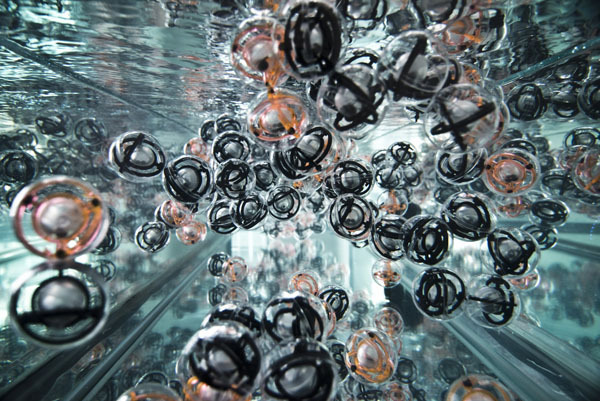From the architect. MIT’s Self-Assembly Lab has exhibited the Fluid Crystallization project as part of the 2013 Architectural League Prize Exhibition at the Parson’s Gallery in New York. The Fluid Crystallization installation – a collaboration between MIT Self-Assembly Lab director Skylar Tibbits and The Molecular Graphics Lab director Arthur Olson – investigates hierarchical and non-deterministic self-assembly with large numbers of parts in a fluid medium.
From the architect. MIT’s Self-Assembly Lab has exhibited the Fluid Crystallization project as part of the 2013 Architectural League Prize Exhibition at the Parson’s Gallery in New York. The Fluid Crystallization installation – a collaboration between MIT Self-Assembly Lab director Skylar Tibbits and The Molecular Graphics Lab director Arthur Olson – investigates hierarchical and non-deterministic self-assembly with large numbers of parts in a fluid medium.
350 hollow spheres are submerged in a 200-gallon glass water-filled tank. Armatures, modeled after carbon atoms, follow intramolecular covalent bonding geometries within atoms. Intermolecular structures formed as spheres interacted with one another in 1, 2, or 3-Dimensional patterns. The highly dynamic self-assembly characteristic of the system offers a glimpse at material phase change between crystalline solid, liquid, and gaseous states. Turbulence in the water introduces stochastic energy into the system, increasing the entropy and allowing structures to self-assemble; thus, transitioning between gas, liquid, and solid phases. Polymorphism may be observed where the same intramolecular structures can solidify in more than one crystalline form, demonstrating the versatile nature of carbon as a building block for life.
Creators: Skylar Tibbits, Founder & Principle, SJET LLC & Lecturer MIT, Department of Architecture; Arthur Olson, The Molecular Graphics Laboratory, The Scripps Institute, CA
Project Team: Graham Francis, Marianna Gonzalez, Amir Soltanianzadeh, Monica Zhou, Veronica Emig
Fluid Crystallization was made possible by support from the Department of Architecture, MIT and the Architectural League of New York.







